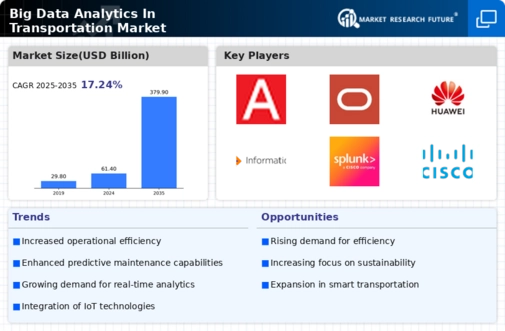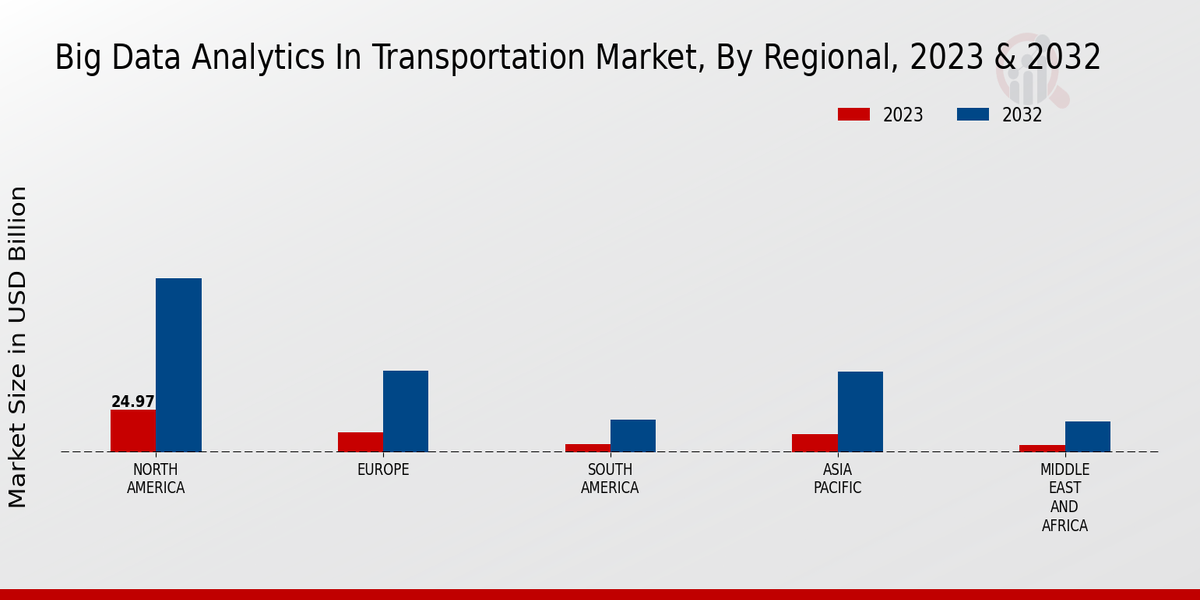Market Growth Projections
The Global Big Data Analytics In Transportation Market Industry is poised for substantial growth, with projections indicating a market size of 61.4 USD Billion in 2024 and an anticipated increase to 379.9 USD Billion by 2035. This growth trajectory suggests a compound annual growth rate (CAGR) of 18.03% from 2025 to 2035. Such figures reflect the escalating adoption of big data analytics across various transportation sectors, including logistics, public transit, and freight management. As organizations increasingly recognize the strategic advantages of data-driven insights, the market is likely to witness significant advancements and innovations.
Enhanced Safety and Risk Management
Safety remains a paramount concern in the Global Big Data Analytics In Transportation Market Industry. The integration of big data analytics enables transportation agencies to identify potential risks and enhance safety measures. Predictive analytics can forecast accident hotspots, allowing for proactive interventions. For instance, data-driven insights have led to improved road designs and traffic management strategies in various regions. As safety regulations become more stringent, the demand for analytics solutions that enhance risk management will likely increase. This trend underscores the importance of leveraging data to create safer transportation environments.
Regulatory Support and Policy Frameworks
Government initiatives and regulatory frameworks play a pivotal role in shaping the Global Big Data Analytics In Transportation Market Industry. Policies promoting data sharing and collaboration among transportation agencies encourage the adoption of analytics solutions. For instance, the European Union's initiatives to enhance cross-border transport efficiency leverage big data to improve logistics and reduce emissions. Such regulatory support not only fosters innovation but also ensures that transportation systems are more resilient and responsive. As the market evolves, the alignment of policies with technological advancements will be crucial for maximizing the benefits of big data analytics in transportation.
Advancements in IoT and Smart Technologies
The integration of Internet of Things (IoT) devices and smart technologies significantly propels the Global Big Data Analytics In Transportation Market Industry. IoT sensors embedded in vehicles and infrastructure generate vast amounts of data, which can be analyzed to improve safety and efficiency. For example, smart traffic lights adapt to real-time traffic conditions, optimizing flow and reducing delays. This technological evolution is expected to contribute to the market's growth, with a projected CAGR of 18.03% from 2025 to 2035. As more cities adopt smart technologies, the reliance on big data analytics will likely intensify, further enhancing transportation systems.
Increased Demand for Efficient Transportation Systems
The Global Big Data Analytics In Transportation Market Industry experiences heightened demand for efficient transportation systems, driven by urbanization and population growth. As cities expand, the need for optimized traffic management and public transportation becomes critical. Big data analytics facilitates real-time monitoring and predictive modeling, enabling authorities to enhance service delivery. For instance, cities like Singapore utilize data analytics to streamline traffic flow, reducing congestion and improving travel times. The market is projected to reach 61.4 USD Billion in 2024, indicating a robust growth trajectory as stakeholders increasingly recognize the value of data-driven decision-making in transportation.
Growing Focus on Sustainability and Environmental Impact
The Global Big Data Analytics In Transportation Market Industry is increasingly influenced by the global emphasis on sustainability and reducing environmental impact. Transportation accounts for a significant portion of greenhouse gas emissions, prompting stakeholders to seek data-driven solutions for greener operations. Analytics can optimize routes, reduce fuel consumption, and enhance vehicle utilization, contributing to sustainability goals. For example, logistics companies are using big data to minimize empty miles and improve load efficiency. As the market is projected to grow to 379.9 USD Billion by 2035, the focus on sustainability will likely drive further investment in analytics solutions.























Leave a Comment